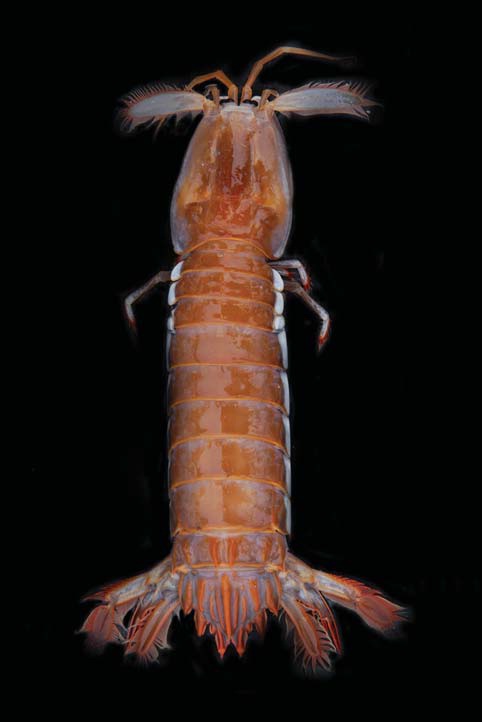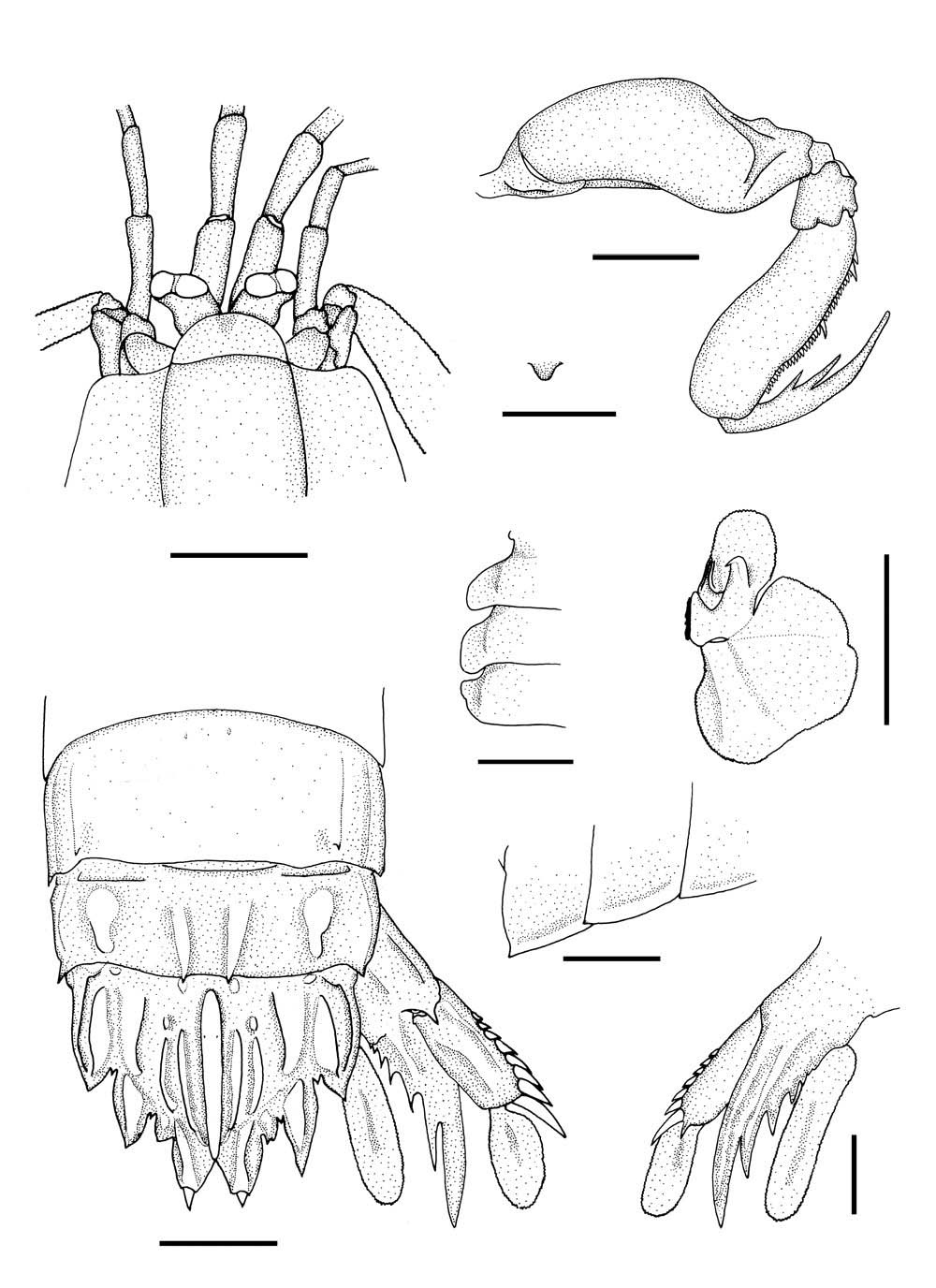



The stomatopods are aggressive predatory marine crustaceans, which are mainly found in tropical and subtropical regions. Among these, a parasquillid stomatopod, Faughnia formosae Manning and Chan, 1997, collected from Jeju Island, is reported for the first time in Korea. The family is easily distinguished from other families by the presence of an asymmetrically bilobed cornea, stout propodus on the raptorial claw, and three primary spines of the uropodal protopod. In the paper, detailed descriptions and illustrations of this species are provided alongside a photograph. A key to the species of Korean mantis shrimp is also presented. As a result of this study, four species of stomatopods including this species are now recorded in Korean fauna.
The stomatopods, commonly called mantis shrimp, are aggressive predators which are found in tropical and subtropical regions (Ahyong, 2001). Large and powerful raptorial appendages, which can be used by ‘smashing’ or ‘spearing’, are their trademark morphological feature (Caldwell and Dingle, 1976).
More than 450 stomatopod species have been described worldwide (Ahyong, 2001), of which only 3 species have previously been recorded in Korean waters:
The specimen was collected from the subtidal zone of Jeju Island by fishing net, and was preserved in 95% ethyl alcohol. A steromicroscope (MZ8; Leica, Wetzlar, Germany) was used for observation and sorting. Images were recorded using a digital camera (Model D7000; Nikon, Tokyo, Japan). Body length, or total length, was measured along the dorsal midline from the apex of the rostral plate to the apices of the submedian teeth of the telson. Morphological terminology is mostly after Ahyong (2001). Specimen examined herein has been deposited in the Marine Arthropod Depository Bank of Korea (MADBK), Seoul National University.
Order Stomatopoda Latreille, 1817
1*Family Parasquillidae Manning, 1995
2*Genus Faughnia Serene, 1962
3*Faughnia formosae Manning and Chan, 1997 (Figs. 1, 2)
Material examined. Korea: 1♂, Jeju Island, Seogwipo-si, Daejeong-eup, Hamori, Moseulpo port, 10 Sep 2006, by fishing net.
Description. Body (Fig. 1) approximately cylindrical; dorsal surface overall pitted and smooth; articulation compressed.
Eye (Fig. 2A) not reaching to end of first segment of antennular peduncle. Cornea asymmetrically bilobed, outer margin longer than inner.
Carapace (Figs. 1, 2A) with indistinct reflected marginal carina; anterolateral angles rounded, not produced anteriorly.
Rostral plate (Fig. 2A) without long apical spine, width 2.6 times longer than median length.
Raptorial claw (Fig. 2B) stout; ischio-meral articulation terminal; dorsal margin of carpus with 2 blunt teeth; occlusal margin of propodus with 3 movable spine and a series of dense pectinations; dactylus slender, bearing 3 teeth on inner margin.
Sternal keel of eighth thoracic somite (Fig. 2C) rounded.
Lateral processes of sixth to eighth thoracic somites (Figs. 1, 2D) broadly rounded, with low ridge; that of seventh slightly wider than sixth.
Endopod of first male pleopod (Fig. 2E) bearing posterior endite.
Telson (Fig. 2F) as long as broad, with 3 pairs of primary teeth (submedian, intermediate, lateral); with 2 spiniform intermediate denticles, 1 spiniform lateral denticle. Dorsal surface with median carina and 5 pairs of longitudinal carinae (accessory median, anterior submedian, and lateral slightly interrupted, anterior intermediate and marginal uninterrupted) in addition to carinae of all primary teeth extending onto surface of telson. Ventral surface of telson smooth, without postanal carina.
Posterolateral angles of fourth to sixth abdominal somites (Fig. 2G) bearing low lateral, marginal carinae, except for submedian; sixth somite with spinule produced ventrolaterally.
Uropod (Fig. 2H) with exopod having 8 movable spines; protopod bearing well-developed spinules, outermost largest, flanked proximally by 4 smaller spinules as well as some denticulation on inner margin.
Distribution. Japan, Taiwan, the Philippines, Thailand, and Korea (Jeju Island).
Coloration. Color in life mostly dark-orange, with antennules, most of carapace, thoracic and abdominal somites, telson largely dark-orange. Antennal scales, rostral plate, lateral margins of carapace, pereiopods, and most of uropods whitish; lateral processes of thoracic somites and lateral margins of abdominal somites distinctly white, appearing as a pair of white bands along the body. Tips of pereopod, and movable spines, as well as distal segment of uropodal exopod reddish orange.
Remarks. The present species,
Key to the species of Korean mantis shrimps
1. Telson with at least 4 densely arranged intermediate denticles. Median carina of carapace distinct, not interrupted at base of anterior bifurcation. Lateral process of fifth thoracic somite bilobed ??????????????? Oratosquilla oratoria
- Telson with no more than 3 intermediate denticles. Median carina of carapace indistinct. Lateral process of fifth thoracic
somite entire, rounded ?????????????????????????????????????? 2
2. Protopod of uropod bearing three primary spines. Cornea asymmetrically bilobed. Dorsal surface of telson with median and 5 pairs of longitudinal carine ???????????????????????????????????????????????????????????????????????????? Faughnia formosae
- Protopod of uropod bearing one or two primary spines. Cornea symmetrically bilobed. Dorsal surface of telson without 5 pairs of longitudinal carinae ??????????????????????? 3
3. Exopod of uropod bearing stout, anteriorly recurved distal spines on outer margin. Dorsal surface of telson without long spines ???????????????????????????????? Taku spinosocarinatus
- Exopod of uropod bearing slender, straight distal spines on outer margin. Dorsal surface of telson entirely with long spines ?????????????????????????? Chorisquilla spinosissima
Korean name: 1*돌기갯가재과 (신칭), 2*돌기갯가재속 (신칭), 3*다섯돌기갯가재 (신칭)

